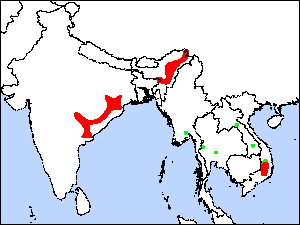
Pale-capped Pigeon
Columba punicea
|
Justification This pigeon has a small, declining,
severely fragmented population owing to destruction of its evergreen
forest habitat and hunting. It therefore qualifies as Vulnerable. |
|
|
|
Threats Its decline is mainly the result of
habitat loss and fragmentation owing to commercial logging, small-scale
timber collection, and clearance of mangroves and evergreen forests for
plantation agriculture, cash-crops, charcoal production and shifting
cultivation. It also suffers high levels of hunting for food, whilst trade
poses an additional, minor threat. |
|
Conservation Although it has been recorded from
numerous protected areas, their contribution to its conservation is not
known, especially given its seasonal and nomadic movements. Indeed,
site-based conservation strategies are unlikely to be successful unless
populations are able to follow seasonal patterns of fruit-ripening within
secure protected sites. |
|
Targets *Conduct further surveys,
particularly in Myanmar, to clarify its current distribution, seasonal
movements and population status. *Conduct research into its ecological
requirements and the relative effects of various threats operating across
its range. *Identify and protect, where appropriate, sites supporting key
populations. *Promote improved management and establish/increase buffer
zones around protected areas supporting key populations. *Enforce strict
hunting controls within all protected areas and devise awareness campaigns
to reduce pigeon hunting wherever this is possible. |
Use Your Browser's Back Button to return to the Previous Page